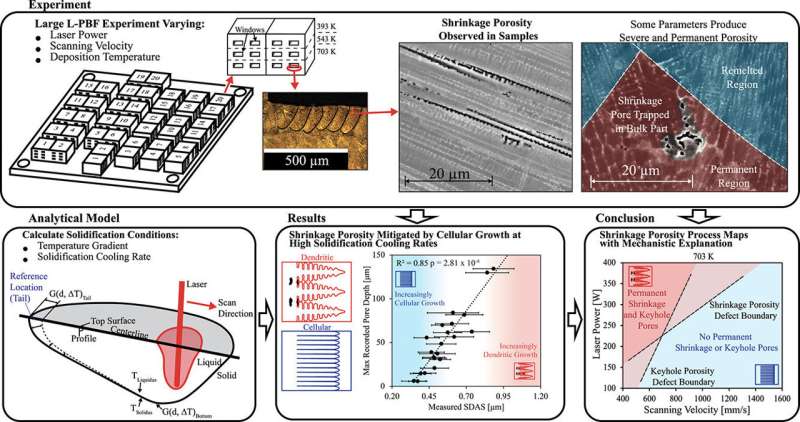
When Mechanical Engineering Ph.D. candidate William Frieden Templeton intended to take a closer look at how laser powder bed fusion (PBF-LB) process parameters influence microstructure, he never expected to find a manufacturing defect previously overlooked in PBF-LB additive manufacturing.
Shrinkage porosity, a common defect in metal castings, forms as metal transitions from its liquid to solid state. The metal volumetrically contracts as it cools and solidifies, and if this contraction cannot be backfilled by the remaining liquid metal because the liquid metal flow paths are blocked by the solidifying microstructure, we get shrinkage porosity.
"These defects occur on the scale of the microstructure and are really hard to spot if you aren't expecting them," said Frieden Templeton. "Using a light optical microscope, they often look like small polishing scratches."
Due to the layer-by-layer PBF-LB print process, remelting could remove these shrinkage pores, or they could be removed during post-printing machining if they are closer to the part's surface, making these defects a nonissue. However, problems arise when these pores form deep enough that the next metal layer can't remove them during remelting.
"This is the time anyone has explained the occurrence of shrinkage porosity based on solidification and L-PBF processing fundamentals," said Sneha Narra Prabha Narra, Assistant Professor of Mechanical Engineering.
"Further, we were also able to map it as a function of processing conditions and present this information in a form that is easy for researchers and engineers to interpret during process parameter development. This was only possible because of the interdisciplinary and collaborative nature of this project."
Frieden Templeton was taking a solidification processing course taught by co-author Chris Pistorius, Professor of Materials Science and Engineering; around the same time, he was characterizing the samples involved in this work, which enabled him to make the connections between his coursework and research quickly.
"This is a fitting example of what happens when students are open to applying their graduate coursework to their ongoing research," said Narra. "This is often the case at CMU. The mechanistic understanding of defect formation allowed us to propose mitigation strategies. "
Process parameter development for PBF-LB has made significant progress in recent years, enabling the process to achieve consistently high part quality. While the results of this work likely won't alter previously-established process parameters because most are created at low printing temperatures (around 100°C). In future work, manufacturers will need to pay attention to this defect in AM.
"This will particularly impact researchers and manufacturers working towards developing process parameters for printing at high temperatures closer to 500°C and printing complex geometries susceptible to local temperature build-up," said Frieden Templeton.
"Beyond our research findings, I want to emphasize how important it is for researchers to keep an open mind when collecting and analyzing data. We started this project with no expectation to observe shrinkage porosity because it's not often mentioned in existing literature."
This research was done in collaboration with researchers at the University of Pittsburgh; Albert To, Shawn Hinnebusch, and Seth Strayer, who used their additive manufacturing simulations to design these experiments and fabricated the samples as part of an ongoing project supported by NASA.
The work is published in the journal Acta Materialia.
More information: William Frieden Templeton et al, A mechanistic explanation of shrinkage porosity in laser powder bed fusion additive manufacturing, Acta Materialia (2023). DOI: 10.1016/j.actamat.2023.119632
Citation: Shrinkage porosity identified in laser powder bed fusion additive manufacturing (2024, February 13) retrieved 13 February 2024 from https://techxplore.com/news/2024-02-shrinkage-porosity-laser-powder-bed.html
This document is subject to copyright. Apart from any fair dealing for the purpose of private study or research, no part may be reproduced without the written permission. The content is provided for information purposes only.
